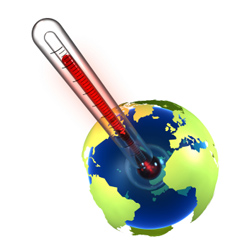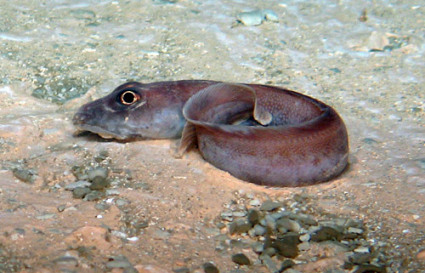In modern times, climate change often refers to the increase in the Earth's average temperature. Although the reality of climate change was disputed at first, there is now a plethora of evidence outlining not only how and why the Earth's temperature is increasing, but also the extent to which it will continue to increase in the future. Since the 20th century, the Earth's average temperature has increased by about 0.7° Celsius and is expected to continue to increase by about 0.2° Celsius per decade. The oceans absorb 80-94% of the heat added to the Earth by climate change.

It has been seen in the majority of the papers that we have read that most species will react negatively over long term heat stress. Thermal stress can prevent species from proper development,
migrating,
reproducing, and more. However, although there have been a vast number of studies, there are still many aspects of this topic that need to be examined further. Many of the studies below do not necessarily push the boundaries of thermal tolerance to the extreme. For instance, the paper we read as a class about sea urchins utilized a high temperature of 18 degrees Celsius. It was noted later in the paper that some sea urchins are already living in environments that reach these temperatures and thus the long term effects at higher temperature are unknown. It is also important for studies to take into consideration not only the effects of temperature, but also how an increase in temperature affects other components of the environment, such as
acidification and
ocean currents, and how these things work together to affect different organisms.
Effects of Temperature on Eelpouts
Thermal limitations for aquatic species largely are due to limitations in blood flow and oxygen levels. This study by Portner et al. (2007) looked at the common eelpout. They live in very cold seas and show higher mortality rates in unusually hot summers and lab settings. Increased temperatures both increase the eelpouts need for oxygen and reduces the oxygen’s solubility in water. The larger individuals are more prone to dying in warm conditions than smaller fish. The results showed that the amount of time exposed to higher temperatures was an important factor to the survivability of the fish. Another factor is that other fish will be likewise affected, and the changes in food sources could also affect the survivability of eelpouts.
Effects of Decreasing Temperatures
Many of the studies on the effects of global climate change on biodiversity have been focused on a steady increase of global temperatures. However, temperatures often fluctuate. The increase in temperatures has led to some invasive marine species in the Caribbean to expand poleward. Despite having a greater thermal range then the native species, when cold spells occur they can cause a reset of the environment by killing the invading Caribbean species. It is important to not only focus on temperature increases but also decreases when looking at the effects of climate change on marine populations.
Effects of Temperature Changes in Low Connectivity Areas
A
study by Hiddink and Coleby (2011) found that temperature increases caused a greater species richness in poleward latitudes. However, despite their hypothesis, areas of low connectivity, such as the Baltic Sea, also show this increase even though it is more difficult for the species to move. This led them to believe the new richness in species may be due to
salinity changes and researchers need to pay closer attention to areas of low connectivity when making climate change models.
Effects of Temperature During the Winter
A
study by Figueira and Booth looked at the effects of temperature increases on various marine species during the winter time. In the past these marine species have been forced to stay in certain areas because the water temperature gets too cold for them to survive in southern areas. However, the steady increase of sea temperature that is expected to continue over time could allow greater thermal expansion during the winter time. It is expected that the majority of these marine species will be able to survive throughout the winter in even the most southern areas. Further studies need to be conducted onto how this southern migration will effect the native species living in these areas.
Water Temperature as a Limiting Factor
A
study by Smith, Medeiros, and Bayley looked a lagoon that has recently been reintroduced to sea water. Most of the local marine species have been able to establish themselves in this new environment. However, one very important herbivore, common periwinkle, has been unable to establish itself. The reason it cannot survive in this lagoon is believed to be because of the high temperatures reached during the summer months. This means that macroalgae have a hard time thriving in the environment. This further shows that the stress of high temperature can lead to a harsh constraints on new and existing environments.
 Temperature Control of Larval Distribution
Temperature Control of Larval Distribution
This
study by O'Connor looked at how an increase in temperature would affect larval development of 72 different marine species. As previously mentioned, temperature effects the rate of many biochemical processes and thus is important to study the effects of increased warming. They found that animals traveled far less in warmer than cooler weathers. They believe that this is because in cooler waters the larvae have yet to develop completely and travel more before starting their next development in order to try and find warmer areas to increase metabolism and body processes. This means that in warm areas, species that are endangered will need to live closer together. I found it interesting that they found that the predictions they made from their model hold true for 'virtually all marine animals with a larval life cycle'.
Movement and Adaptation of Marine Ectotherms compared to Terrestrial Ectotherms
The latitudinal shifts of marine ectotherms in response to climate warming can be more accurately predicted than the latitudinal shifts of terrestrial ectotherms. This is because marine ectotherms inhabit a range very close to their thermal limitations. They expand and contrast at both poleward and equatorward ends of their range in response to temperature change, whereas the movement of terrestrial ectotherms are more complex. (Sunday et al, Thermal tolerance).
[JPW: In an earlier meeting there was discussion about why it is important to understand the rate of larval growth given particular genotypes in particular environments (reaction norms). Here are links to some references showing that rapid larval growth leads to greater larval survival.]
Back to
Introduction 



 Temperature Control of Larval Distribution
Temperature Control of Larval Distribution

Comments